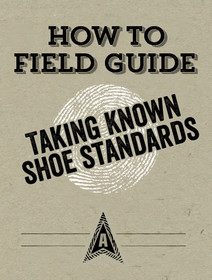Posted by QC on 30th Aug 2018
How To Guide: Taking Known Shoe Standards
In some criminal cases, the evaluation of impression evidence can mean the difference between innocent and guilty. In his book, "Footwear Impression Evidence: Detection, Recovery, and Examination," William Bodziak recounts a homicide case, in which impression evidence almost convicted the wrong man. But due to careful examination of the impression evidence against a known standard from the suspect, he was vindicated.
While it is vital to accurately collect impression evidence from the scene of a crime, this story demonstrates that it is equally important to accurately collect known standards. In addition, known standards are necessary because collected impressions are always compared to known standards (not the other way around).
The Technical Procedure for Impression Evidence Analysis and Processing from the North Carolina Department of Justice states that the generally accepted method for obtaining such standards is by adhesive overlays. In another book by Bodziak, "Forensic Footwear Evidence," he explains that transparent adhesive overlays are an excellent method of comparison because they can be superimposed over an impression taken from the crime scene. He goes on to also mention that multiple known standards should be created to eliminate variability created by different conditions.
To create a known impression, all you need is: a transparent lifter, a fingerprint brush, fingerprint powder, a rubber roller, and your known shoe.
STEP 1 – CLEAN
Clean the outsole of any heavy debris. Take care not to dislodge embedded rocks from the tread pattern.
STEP 2 – POWDER
Apply an even coating of black fingerprint powder to the outsole.
STEP 3 – APPLY
Remove cover sheet on lifter and place on a smooth flat surface. Place the outsole in contact with the adhesive side of the lifting sheet. This can be done either by stepping on the film with the shoe, or placing the shoe firmly against the film on
a countertop.
STEP 4 – SMOOTH
Ensure even contact between the shoe and film by either rolling the foot in the shoe or gently smoothing the film over the outsole with your hand. Be careful not to "push" the film as this may case the film to skip over the surface and negate the lift.
STEP 5 – PRESERVE
Replace cover sheet with a rubber roller. Begin by rolling over impression area then out from center to edges to remove any air bubbles. Label the lifter with the appropriate shoe description (size, side, owner, etc.) and case information.
Resources:
Standard for Terminology Used for Forensic Footwear and Tire Impression Evidence


